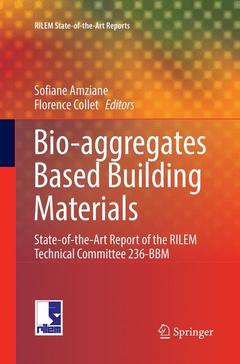Chapter 1. Chemical composition of bioaggregates and their interactions with mineral binders.- 1.0 Introduction.- 1.1 Composition of hemp stem.- 1.2 Processing of hemp stem and microstructure of hemp shiv.- 1.3 Cell wall components.- 1.4 Chemical composition of bioaggregates.- 1.5 Surface characterization of bioaggregates – adhesion between lignocellulosic aggregates and a mineral binder.- 1.6 Chemical interactions between bioaggregates and mineral binders.- 1.7 Conclusion.- References.- Chapter 2. Porosity, pore size distribution, micro-structure.- 2.0 Introduction.- 2.1 Techniques used to measure porosity.- 2.2 Conclusion.- References.- Chapter 3. Water absorption of plant aggregate.- 3.0 Introduction.- 3.1 Wetting of porous, heterogeneous surfaces.- 3.2 Transfer phenomena in a porous medium.- 3.3 Analogy with adhesion of mortars to a porous support.- 3.4 Overview of the processes of binder/wood adhesion.- 3.5 Conclusion.- References.- Chapter 4. Particle Size Distribution.- 4.0 Introduction.- 4.1 General characteristics of shiv particles.- 4.2 Sieving methods .- 4.3 Image-processing methods.- 4.4 Image-analysis.- 4.5 Characterization of the PSD.- 4.6 Conclusions.- References.- Chapter 5. Bulk density and compressibility.- 5.0 Introduction.- 5.1 Density and porosity, case of hemp shiv.- 5.2 Bulk compressibility.- 5.3 Conclusions and perspectives.- References.- Chapter 6. Hygric and thermal properties of bio-aggregate based building materials.- 6.0 Introduction.- 6.1 Hygric properties.- 6.2 Thermal properties.- 6.3 Concluding remarks on hygrothermal behavior of bio-aggregate based building materials.- References.- Chapter 7. Bio-aggregate based building materials exposed to fire7.1 Introduction.- 7.2 Fire reaction.- 7.3 Fire resistance.- 7.4 Real scale fire tests.- 7.5 Other quaint matter fire test.- References.- Chapter 8. Durability of bio-based concretes.- 8.0 Introduction.- 8.1 Accelerated aging protocols for bio-based construction materials.-8.2 Aging of bio-based concretes.- 8.3 Aging of natural fibres-cement composites.- 8.4 Concluding remarks.- References.- Chapter 9. Effect of testing variables (method of production).- 9.0 Introduction.- 9.1 Materials and methods.- 9.2 Results.- 9.3 Conclusion.- Acknowledgments.- References.- APPENDIX : Technical Commitee Report - Rilem TC 236 BBM - Bio based Building Materials - Round Robin test for hemp shiv Characterisation.- Round Robin Test For Hemp shiv Characterisation.- Part 1 : Evaluation Of Initial Water Content And Water Absorption.- 1 Introduction.- 2 Material.- 52%.- 18%.- 2.1 Microscopical description.- 3 Initial Water Content.- 3.1 Methods.- 3.2 Results.- 3.3 Concluding remarks on initial water content.- 4 Water Absorption.- 4.1 Description of the experimental methods.- 4.2 Results.- 4.3 Concluding remarks.- Summary of Findings.- Round Robin Test For Hemp shiv Characterisation.- Part 2: Bulk Density And Particle Size Distribution.- 5 Introduction.- 6 Material.- 52%.- 18%.- 7 Bulk Density.- 7.1 Methods.- 7.2 Results.- 7.3 Concluding remarks on bulk density.- 8 Particle Size Distribution.- 8.1 Sieving method.- 8.2 Image processing.- 8.3 Comparison between sieving and image analysis results.- 8.4 Concluding remarks on Particle Size Distribution.- Summary Of Findings.- Acknowledgements.- Round Robin Test For Hemp shiv Characterisation.- Part 3 : Thermal Conductivity.- 9 Introduction.- 10 Material.- 52%.- 18%.- 11 Thermal Conductivity.- 11.1 Experimental methods.- 11.2 Results.- 11.3 Concluding remarks.- Summary Of Findings.- Acknowledgements.





